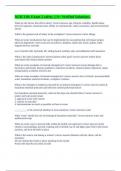NUR 310: Exam 2 safety || A+ Verified Solutions.
What are the factors that affect safety? correct answers age, lifestyle, mobility, health status,
level of cognition, emotional state, ability to communicate, safety awareness, and environmental
factors
What is the greatest risk of safety in the workplace? correct answers a latex allergy
What are some mechanisms that can be implemented to our patients that will ensure proper,
physical alignment? correct answers use pillows, blankets, hand rolls, boots, splints, ankle
support devices, and aids
use of transfer belt, hydraulic lift, sliding board, mobility aids, and additional staff assistance
What is the Joint Commission's newest patient safety goal? correct answers reduce harm
associated with clinical alarm systems
What are some examples of external emergencies? correct answers severe damage due to
hurricanes and floods, disease epidemics, industrial accidents, chemical plant explosions, major
transportation accidents, terrorist acts
What are some examples of internal emergencies? correct answers loss of electric power/portable
water, hazardous material incidents, workplace violence
What is the emergency readiness expected for an internal emergency? correct answers safety &
hazardous material protocols and infection control policies/practices
For hazardous material protocols, what are the steps one should follow? correct answers 1.
protect self and avoid contact
2. approach scene with caution
3. contain in one place
4. decontaminate as much as possible at/close to scene
__________ is the universal antidote in most situations. correct answers water
What "tools" should one use for biological hazardous materials? correct answers water and
antibacterial soap
What are some ways to prevent falls within the health care agencies? correct answers orient
clients to surroundings, provide walking aids if needed, use of call light, place bed in the lowest
position, and lock the beds in place
What is the nurse's role during a seizure? correct answers Remain with the client; call for
assistance
Do not restrain the client or place anything in the mouth
Protect the head & turn client on side
, Loosen tight clothing
If seizure occurs while ambulating or sitting in a chair, cradle head or provide a cushion or
support for protection against head injury
Time the seizure duration
Observe the progression of the seizure, noting the sequence and type of limb involvement.
Observe skin color. When the seizure allows, check pulse and respirations.
Apply oxygen & suction oral airway prn
Administer anticonvulsant or antiepileptic medications, as ordered
When seizure subsides, reorient, reassure & explain what happened. Assess for injuries, measure
oxygen saturation & VS. Provide hygiene. Allow for verbalization of feelings.
What type of seizure occurs more in children? correct answers febrile seizure
Restraints correct answers Protective devices used to limit the physical activity of client or body
part
What are the two reasons to use restraints? correct answers 1) prevent harm to client and others
2) in order to provide medical care
What are the 3 types of restraints used? correct answers physical, chemical, and seclusion
What are the 5 criteria/standards restraints have to meet in order to use them? correct answers 1)
restricts patient's movement as little as possible
2) safe for the patient
3) doesn't interfere with treatment
4) readily changeable
5) discreet as possible
Least to most restrictive restraints: correct answers 1. side rails
2. mitts
3) soft limb wrist
4) vest
5) 4 point soft hard limb- velcro or leather
What is the nurse or LIP doing during the initial monitoring after applying restraints? correct
answers checking the patient at least every 15 minutes for the first hour
Controlled substances are: correct answers kept under lock, require special inventory forms, has
certain documentation requirements, has certain discarding procedures, and requires an end-of-
shift count
T/F: When pulling narcotics out of the package, you start from the bigger number instead of
pulling from #1. correct answers True
Verbal or telephone orders must be cosigned within (usually) what time frame? correct answers
24-48 hrs




